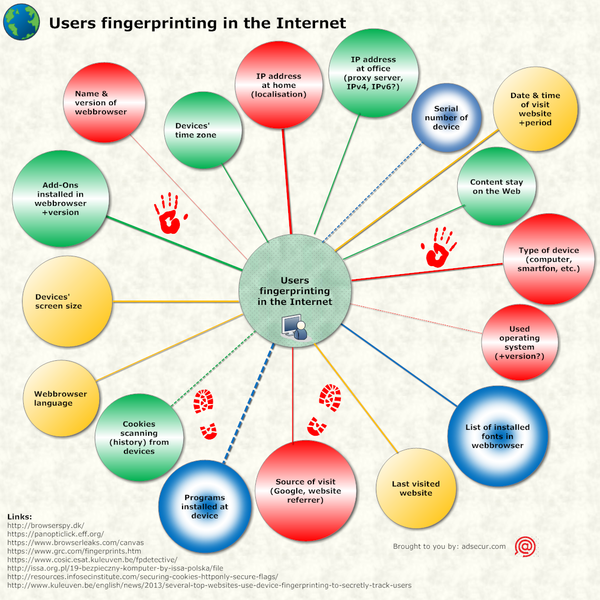Web Tracking is not the same as website tracking. The latter refers to analyzing things about any website. That’s done using different tools available to webmasters. Web Tracking is about tracking you and your activities on websites. This post explains what is Web Tracking, what are Trackers in browsers and how websites track you online. We also list some Browser tracking tests you can take.

[Image source: Wikimedia Commons]
How do websites track you online?
There are many methods, like Browser Fingerprinting, that make it easier for websites to track you on the Internet. Browser fingerprinting allows for the websites to note down different factors unique to your device: Monitor resolution and depth, items like what all websites you were visiting, how many and what fonts are you using, and stuff like that.
All this information is carefully constructed so that they (Internet marketers) get a good browser and device fingerprint that gives you away even if you are trying to hide using Incognito mode on your browser.
The easiest method to track people is to use Cookies. The concept of cookies was introduced with Netscape Navigator to “provide a better experience”. Early cookies were meant to store settings for different websites. Current-day cookies store more than just login information. They keep a tab of what all you are doing on the Internet.
Another case is where websites are bugged. They have small invisible scripts running in the background when you open the site. These scripts too collect as much information about you as possible. Some of the data saved from such bugs are name, location, email IDs, size, make, model of your computer, what browser are you using, what all apps you use, and similar things.
There is not just one thing tracking you. There are many trackers; each tracker would query for different types of data. All these trackers send the data they collect, to a central authority that could be an app or some operating system. This is then saved in an understandable profile format that can be traced to you when you next visit the Internet.
Why is Internet Tracking bad
It sends a chill down the spine to think that some strangers are out there who know everything about your habits. The data sent by different trackers are built into a robust profile. Based on this profile, online marketing companies send you relevant advertisements. Some people like customized advertisements but in most cases, people are scared as to what information about them is available on the Internet.
The profiles are not limited to marketing. Some people can manipulate you in name of helping out. With such data about you with them, the marketers or small-time hackers can try to blackmail you.
Worse, if the profiles contain social security numbers and other sensitive information, your identity can be compromised. Bad people can misuse the information and negatively affect you. With that data, people can easily impersonate others and take a monetary loan in your name.
Next, let’s see what all is available on the Internet to see what data is being tracked.
Read: What are Email Trackers? How to block Email Tracking?
Browser Tracking Tests
Privacy.net – There are some five tools (tests) on privacy.net that tell you what information is likely to be stored in your “online profile” created by trackers. The first one is the basic test that tells you your IP address, your location, Internet Service Provider Name (ISP Name), your computers’ operating system, browser in use and screen resolution. It also checks if data can be leaked through autofill, what all websites you are logged on, and similar things. It also does fingerprint analysis which looks a bit dangerous.
Panopticlick – checks what all data your browser is sharing with different websites. For example, is your browser blocked tracking ads, whether your browser is blocking invisible trackers. It also tells you if your browser fingerprint is unique. It shouldn’t be unique as being unique means like giving away your whole online profile to some stranger. The “Show full results for fingerprinting” option below the first table can be scary if you look into it.
Amiunique.org can run your fingerprint test to see if data can be traced back to you. Just click on View my Browser Fingerprint button. You may be surprised how much do these marketing people know about you and your device.
The Station X blog has a page that lists more of such sites that help you understand what all data of yours can be collected.
Coveryourtracks.eff.org shows you how trackers see your browser, providing you with an overview of your most unique and identifying characteristics.
This explains how to companies or websites track your activity on the Internet. WE hope you find this post useful.
What is web browser tracking?
Web browser tracking refers to monitoring users’ online activities by recording the sites they visit and interactions they make on the Internet. Websites often place cookies and small data files onto users’ browsers, which help track and personalize their web experience.
How do I stop web tracking?
Enable the “Do Not Track” feature in your browser settings to mitigate online tracking. This will inform websites that you prefer your activities not to be tracked. However, not all sites honor this request. For stronger privacy, consider using privacy-focused browsers, VPN software or adding anti-tracking browser extensions.
Now read: How to enable & configure Tracking Prevention in Edge.
Leave a Reply